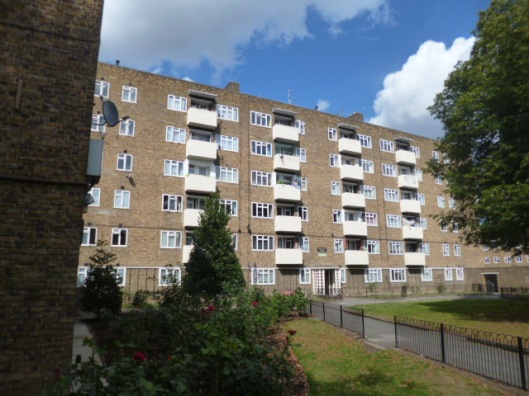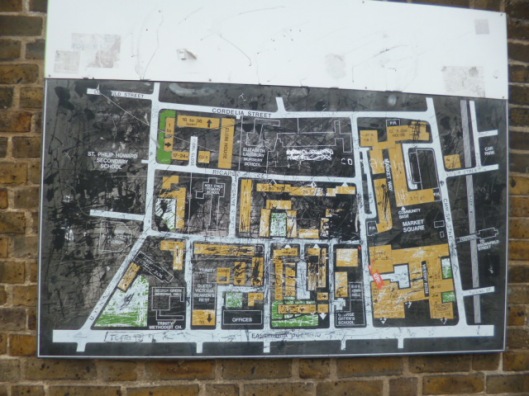Last week, I looked at the origins of the Lansbury Estate and its early development. I finished with the question: what did the Lansbury mean to the people who lived there?
Well, according to the survey carried out by Ruth Glass and John Westergaard, most of them loved it. The lighterman’s wife who had moved from a Limehouse basement said: (1)
This is what I’d hoped for. I’ve waited seven years for it. We were so desperate, we would have gone almost anywhere. I’m glad we didn’t, we belong round these parts.
The woman who had moved from her mother’s home in Millwall where her family of five had lived in two rooms said simply ‘I never thought I’d see such luxury’.
This wasn’t hype. Of the incomers, 60 per cent had shared their previous dwelling, 63 per cent had had no access to an inside toilet and 73 per cent had had no access to a bathroom or even to a fitted bath. The 1951 census showed 72 per cent of Poplar households lacked their own bathroom.
This was the world left behind. It didn’t mean the new residents were blindly grateful – there were complaints about lack of play space and mothers who wanted to go to work criticised the lack of nursery provision.
In fact, work was not so much desire as necessity. The rents (including rates) of the new homes ranged from 25s (£1.25) for three rooms to 35s (£1.75) for five rooms at the end of 1951 – at a time when two fifths of the estate’s breadwinners earned less than £7 a week. All the tenants paid more to live in the Lansbury than their previous accommodation; two thirds paid twice as much.
There was criticism, too, that the range of accommodation provided did not meet local needs. Over 60 per cent of Lansbury households had young children under 10 years of age but only 27 per cent of the dwellings were houses or ground floor maisonettes with gardens.
Who were the new residents? It was said that 80 per cent of the tenants were ‘outsiders’. And it was true that those displaced by the redevelopment were not automatically given homes in the new estate – they were moved according to waiting list dictates to new developments as accommodation became available.
But in, fact, over half of all householders in Lansbury had been living in Poplar before they moved, and another fifth had come from the East End boroughs of Stepney, Bethnal Green and Shoreditch.
It was still an overwhelmingly local and working-class population. The men worked in traditional East End trades – 90 per cent of the chief wage earners were manual workers, 28 per cent worked on the docks or in ancillary trades. Almost two thirds lived within two miles of their place of work.
For Glass and Westergaard, this was an enormous strength of the Lansbury. They saw in the new Estate:
the neighbourliness, the local patriotism, the spirit of give and take, which are found everywhere in the East End. Families have helped one another in the business of moving in; housewives look after the children of neighbours; the Coronation was celebrated with the traditional street parties. Above all, most people in Lansbury have a great affection for their own borough and the East End; they are quite right when they say that ‘there are wonderful people in Poplar’.
In this, they anticipated the 1957 study of Michael Young and Peter Wilmott, Family and Kinship in East London. This panegyric to the old East End slated the suburban estates to which many displaced residents were decanted precisely for breaking up such networks of self-help.
For all this, the neighbourhood units beloved of town planners never really developed a life of their own – people’s actual lives and affiliations were too complex to be so readily socially engineered.
With the impetus of the Festival of Britain gone, the Estate was, in any case, slow to develop. Lansbury’s housing was due for completion by 1970. In the event, the Greater London Council added the last element to the overall scheme – on Pigott Street – in 1982.
The shopping precinct, designed by Frederick Gibberd – the first pedestrianized shopping street in Britain and one of the more eye-catchingly modern elements of the overall plan – was ready for 1951 but not finally completed till the early seventies. Bartlett Park, the Estate’s main open space, wasn’t begun until 1959.
And the Lansbury Estate came to seem almost anachronistic even as it was being begun.
In 1951, Harold Macmillan, Housing Minister in the incoming Conservative government, pronounced that the urgent need for more housing must be met by high-rise and high-density development.
 The planning-led interdisciplinary team which had designed Lansbury broke up soon after the Festival and by the mid-50s new-build on the Estate comprised 11-storey point blocks. Fitzgerald House, built in 1968 and towering above the Chrisp Street Market, is 19 storeys high.
The planning-led interdisciplinary team which had designed Lansbury broke up soon after the Festival and by the mid-50s new-build on the Estate comprised 11-storey point blocks. Fitzgerald House, built in 1968 and towering above the Chrisp Street Market, is 19 storeys high.
As tower blocks rose, the docks closed – the East India Docks in 1965 and the last London docks, downstream in Beckton, in 1981. Capitalism, not the housing schemes of the old LCC, killed the traditional East End.
In the end, perhaps, the Lansbury Estate was less the first breath of a new world than the dying gasp of the old.
Initially, the pride that Glass and Westergaard reported was maintained. According to John Jones, a long-time resident, people kept: (2)
the communal areas clean and tidy and there was a porter who looked after the external areas and kept an eye on the youngsters. And, for better or worse, the area policed itself through the local hard men or bookies’ runners and there was no great crime problem.
But by the 70s and 80s things were going downhill. As another resident summarised, ‘The buildings began to develop problems, kids started spraying graffiti and the estate no longer felt safe’. And then, to some, it became a no-go area. It’s a familiar trajectory, rooted in the destructive dynamics of social transition and economic decline.
In 1997, Estate was declared a conservation area. One year later, the Borough of Tower Hamlets set up the Poplar Housing and Regeneration Community Association (Poplar Harca) with a brief to renew the area, particularly those council estates whose residents had voted in a controversial ballot to transfer to this new registered social landlord.
The Lansbury was one such estate and Poplar Harca has invested considerably in the estate and its people. John Jones became the Lansbury Estate’s resident director for the association.
Meanwhile, the onward march of gentrification in the East End has had its impact in the new ‘Festival Quarter’ development on Canton Street.
The Lansbury looks now as though it has stood the test of time. Its unadventurous style came to seem far more compelling as high-rise dreams collapsed, sometimes literally. And its houses and flats still offer good quality, attractive accommodation at more affordable prices at a time when social needs – albeit very different from those of the 1940s – are just as pressing.
We might, after all, dream of those days when we only criticised municipal housing for its lack of ambition.
Sources:
(1) John Westergaard and Ruth Glass, ‘A Profile of Lansbury’, The Town Planning Review, Vol. 25, No. 1 (April 1954)
(2) ‘The Lansbury Estate: Post-Festival development‘, Survey of London: volumes 43 and 44: Poplar, Blackwall and Isle of Dogs (1994)
(3) Quoted in John Crace, ‘Keys to the Future’, The Guardian, 11 July 2001
Hayes People History, The Lansbury Estate 1951 – It’s what Labour Councils do, is a lovely post on the furnished show flat kitted out by the London Cooperative Society.
The Love London Council Housing piece on the Estate has some additional photographs and detail.
Poplar Harca’s webpage on Lansbury details the current work and activities of the association on the Estate.









Just returned to look at this as today’s edition of the Newham Recorder (my local paper) has an estate agent’s advert for a 2 bed flat in the Skylon Apartments for £710,000. As someone who grew up in a Stepney tower block that is truly shocking.
I remember about 20 years ago researching in the TUC archives held at the University of Warwick. I found some papers relating to a request from an American trade unionist (I think it was Walter Reuther of the AFL-CIO and autoworkers) to visit the Lansbury while on a trip to the UK. The reply came back that this would not be possible as the residents were fed up with dignitaries visiting their homes and could take no more! Wish I’d paid more attention to the details.
Best wishes,
Joan
The times we live in! And once the council housing of the Lansbury represented the world of the future – even if its residents did get a bit fed up with all the visitors! Thanks for sharing that story.
Pingback: The Lansbury Estate, Poplar, Part 1: meeting ‘the needs of the people’ | Municipal Dreams
I was walking round the estate last week door knocking for Poplar HARCA. Most of it still looks great, the homes on Elisabeth Close and elsewhere are wonderful. The folly of later tower blocks iloke Fitzgerald house s now clear, many will be demolished and redeveloped as part of the Chrisp Street market redevelopment. Thanks for the detailed and fascinating history.